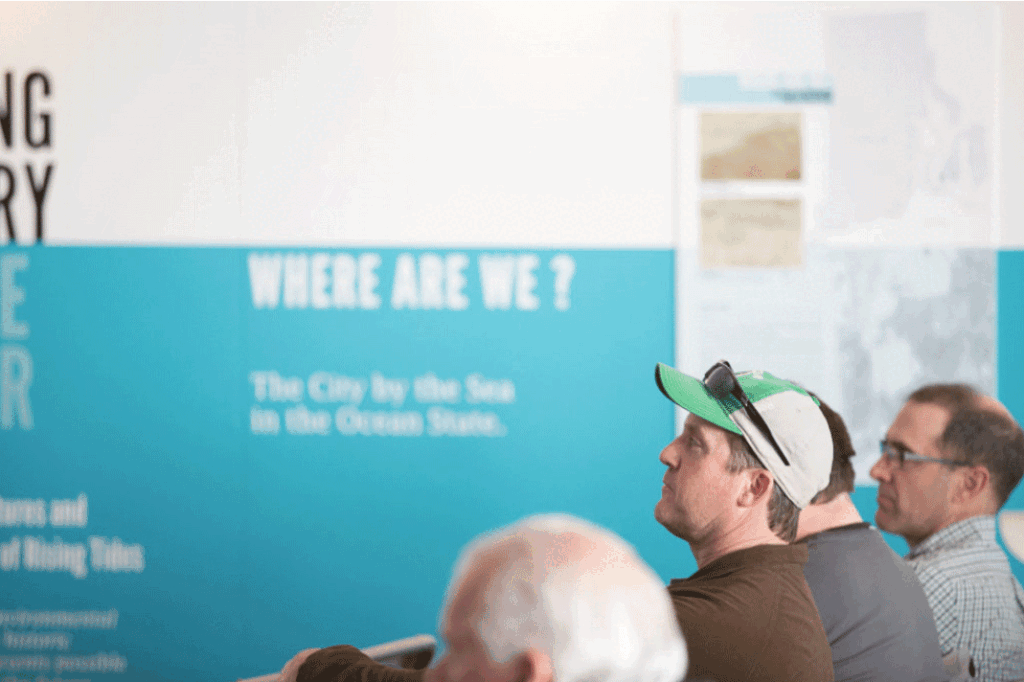Continuing to Keep History Above Water
author: Margot Nishimura
From the National Trust’s Preservation Leadership Forum, May 16th, 2016 | a contribution to their series on climate change and cultural heritage by Margot Nishimura, Deputy Director Collections, Programming & Public Engagement for Newport Restoration Foundation (NRF). This is Part 3 of a series covering the Keeping History Above Water conference held April 10–13 in Newport, Rhode Island. [Part 1| Part 2| Part 3 | Part 4]
If you were to compose a summary of the Newport Restoration Foundation’s (NRF) Keeping History Above Water conference from seven actual tweets, it might go something like this:
- @SenWhitehouse #HistoryAboveWater suggests repealing law of thermal expansion; short of that, we need to act now to minimize causes of SLR [sea level rise].
- “Our history & state are so tied to water, we can’t imagine running away from coast.” Stephanie Zurek @unionstudioarch #HistoryAboveWater
- Adrienne Burke, @Fernandinabeach: When choices have to be made, making the case for heritage as “critical infrastructure” #HistoryAboveWater
- Lisa Craig @HPAnnapolis “Understand the places that matter to your community, not just preservationists” #HistoryAboveWater
- “While we sit & wait & calculate, the waters rise.” -Queen Quet @GullahGeechee #HistoryAboveWater
- “This conference is about NOT reinventing the wheel.” -NRF Exec Dir Pieter Roos #HistoryAboveWater #partnerships @GalvHistory @HPAnnapolis
- @rowemw – form networks with unusual suspects; kill your inner snob; get to work #HistoryAboveWater @NPTRestoration

Attendees listen in during a Keeping History Above Water panel. | Credit: Caroline Goddard
The originating goal of this conference was to educate the preservation community about the risks that climate change—specifically sea level rise—poses to historic structures and neighborhoods. Planning began in earnest with the first program committee meeting on March 2, 2015, right on the heels of the February 2–4 Pocantico meeting that resulted in the Call to Action on Climate Impacts and Cultural Heritage. The Call to Action gave NRF a ready framework, and with one of the largest inventories of 18th-century structures in the United States—many of which sit in a flood zone—we were eager to focus concern on the historic built environment. We sought to advance solutions for greater resiliency in this one particular area.
Sixteen program committee meetings later, and with the help of NRF staff and board members, partner organizations, and generous sponsors, we arrived at day one of a conference that had already become, as the tweets above suggest, about so much more than just the buildings. The built environment did remain a primary focus of the program and conversation, and the case study of practical resiliency measures for NRF’s Christopher Townsend House, built circa 1728 at 74 Bridge Street, was a popular centerpiece. But when “adaptation” was proposed as the essential guiding principle at the end of the first full day of plenary sessions, it was clear that this principle applied to communities, attitudes, and policies as much as to infrastructure and buildings. It was also clear that further progress toward protecting costal heritage, whether tangible or otherwise, would require participation from multiple fields of study and practice as well as from the private, nonprofit, and government sectors. Thankfully, all of these were represented at the conference, and they were all ready to get to work.
Posts in this series have delved into the topics and lessons learned at the conference, and there are also summary posts on the news page of the conference website. So what comes next?
NRF is committed to continuing support for the work begun at Keeping History Above Water first and foremost by keeping the conference website live and updated with news and events for the multidisciplinary community concerned with protecting coastal heritage, especially from the impacts of sea level rise. Photos from the conference, video of all plenary sessions, and a summary of press coverage (from the Newport Mercury to the Chennai Hindu) will be available soon. We will be adding a bookshelf feature to the resources page, which already has extensive links to climate change mapping tools, reports and case studies, and glossaries of terms. To keep this a useful hub for preservation professionals, policymakers, and community members, we will need your help—please send information about new work in the field, either online or in print, to historyabovewater@newportrestoration.org.
The 74 Bridge Street Resiliency Case Study project, which was exhibited onsite during the conference, will soon be published in both print and PDF forms. And more news on a conference publication, to be co-edited by Jeremy C. Wells—from the Architecture and Historic Preservation department at the Roger Williams University School of Art—and the National Trust’s Shantia Anderheggen, is pending. This continuing activity will eventually reside with NRF’s new research center for the study of historic preservation and material culture, under the auspices of which the conference was organized. NRF will continue to welcome opportunities to partner with like-minded individuals and organizations, locally and nationally, on the development of resources and events that further the knowledge shared and advances made at Keeping History Above Water.
Of course, if you would still like a blow-by-blow of the action, I can unhesitatingly recommend scrolling through the full (and extensive!) Twitter and Instagram feeds using the #HistoryAboveWater hashtag. To make sure you don’t miss any news of continuing activities on the conference theme, please follow us @nptrestoration.
Margot McIlwain Nishimura is the deputy director for collections, programming and public engagement at the Newport Restoration Foundation.
[gdlr_button href=”http://forum.savingplaces.org/blogs/special-contributor/2016/05/13/continuing-to-keep-history-above-water” target=”_new” size=”small” background=”#26afc2″ color=”#ffffff”]original article [/gdlr_button]

